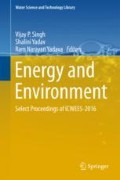Abstract
The increasing population pressure on land in urban areas also adding the pressure on available fresh water sources, urban green spaces, biodiversity, and also on air and eco system. Another important issue of concern is the safe disposal of the ever-growing magnitude of urban waste. These key issues are important to be re-thinked with basic urban infrastructure planning, housing, transport, system, health infrastructure, and other allied civic amenities, required. All these issues necessitate a realistic approach to environmental policy with the basic urban planning of town and cities. The urban population of India as per 2011 Census was 377.10 million, with an average growth of 31% over the last decade, and accounting for 31.16% of the country’s total population. This is projected to be reach to 600 million by the year 2030(1). Thus in, the developmental policies decisions shall be multifunctional and participatory, taking into account the, environmental and other related issues and concerns of citizens. India is facing a typical problem of ground water table falling at a fast rate due to reduced recharge, and unplanned water withdrawal for agriculture and industry. Permeable pavements, if adopted for walkways, parking lots, can help in improving recharging of rainwater. This paper discusses technical information on the application, and necessity of pervious concrete pavements in urban areas, along with many of the environmental and economic benefits of using pervious concrete.
Access this chapter
Tax calculation will be finalised at checkout
Purchases are for personal use only
References
Bean1 EZ, Hunt1 WF, Bidelspach DA, Burak RJ (2004) Study on the surface infiltration rate of permeable pavements. In: 1st water and environment specialty conference of the canadian society for civil engineering, Saskatoon, Saskatchewan, Canada 2–5 June 2004
Brown HJ (2013) Pervious concrete research compilation: past, present and future updated, August 2013. Concrete Industry Management Program, Middle Tennessee State University
Environmental survey report-TERI-2014
Green highways: an initiative towards sustainable development press information Bureau Government of India, 28 Aug 2015
Gupta S (2010) Design of porus pavements; CE682 infrastructure and transport planning. Indian Institute of Technology, Kanpur, 6 Mar 2010
Harshavarthana Balaji M, Amarnaath MR, Kavin RA, Jaya Pradeep S (2015) Design of eco-friendly pervious concrete. Int J Civil Eng Technol (IJCIET) 6(2). ISSN 0976–6308 (Print), ISSN 0976–6316 (Online)
India: Greenhouse Gas Emissions 2007, Ministry of Environment and Forests Government of India, May 2010 (INCCA Indian Network for Climate Change Assessment). IPCC report-2001
Kataria1 BM, Pathak VB, Shah JA (2013) Sustainable development a rethinking of, construction industry in India. Int J Innovative Res Sci Eng Technol 2(10)
Khurd VG, Nitish M (2015) Experimental study of properties of pervious, concrete as a pavement material. Int J Adv Eng Nano Technol 2(9)
Nadgouda K, Ghadi P, Gharat M, Gurav R, Margaje T, Shirke E (2014) The use of pervious concrete in rainwater, management. Nirma Univ J Eng Technol 3(1)
Presentation on: Porous Pavement/Groundwater, Recharge 19382 Cape May, NJ 08204 Daniel Wible, P.E., L.E.E.D. A.P. Cahill Associates Environmental Consultants. www.thcahill.com
Ravindran KT. Chennai floods present a lesson in urban planning, Dec 25. Hindustan Times, Chennai
Shah DS, Pitroda J, Bhavsar JJ (2013) Pervious concrete: new era for rural road, pavement. Int J Eng Trends Technol (IJETT) 4(8) (Report of the RMC Research & Education Foundation)
Solis AV, Durham SA, Ramaswami A. Providing stormwater management solutions in Rajkot, India. A pervious concrete system demonstration. Int J Constr Environ 2(3):135–154
Sri Ravindrarajah SR (2010) Environmental friendly pervious concrete for sustainable construction. Nanyang Technological University, Singapore & University of Technology, Sydney, Australia. In: Yukari A, 35th conference on our world in concrete and structures, University of Technology, Sydney, Australia, 25–27 Aug 2010, Singapore
Statistics Related to Climate Change in India, Ministry of Statistics and Programme Implementation Government of India, Central Statistical Office, Social Statistics Division, New Delhi, November, 2013. www.mospi.gov
Tayabji S (2015) New Delhi workshop—concrete pavements: current, developments. World Bank, Feb 2015
Thorpe D, Zhuge Y (2010) Advantages and disadvantages in using permeable concrete pavement as a pavement construction material. In: Egbu C (ed) Proceedings of 26th annual ARCOM conference, 6–8 Sept 2010. Leeds, UK
Uma Maguesvaria M, Narasimhab VL (2013) Studies on characterization of pervious concrete for pavement, applications. In: 2nd conference of transportation research group of India (2nd CTRG) 1877-0428 © 2013. Elsevier
Author information
Authors and Affiliations
Corresponding author
Editor information
Editors and Affiliations
Rights and permissions
Copyright information
© 2018 Springer Nature Singapore Pte Ltd.
About this paper
Cite this paper
Shrivastava, A.K., Yadav, S., Yadav, L.S., Khan, S., Khan, A.R., Sharma, S. (2018). Global Warming Issues—Need for Sustainable Drainage System in Urban Areas—Green Construction Technologies. In: Singh, V., Yadav, S., Yadava, R. (eds) Energy and Environment. Water Science and Technology Library, vol 80. Springer, Singapore. https://doi.org/10.1007/978-981-10-5798-4_2
Download citation
DOI: https://doi.org/10.1007/978-981-10-5798-4_2
Published:
Publisher Name: Springer, Singapore
Print ISBN: 978-981-10-5797-7
Online ISBN: 978-981-10-5798-4
eBook Packages: Earth and Environmental ScienceEarth and Environmental Science (R0)

